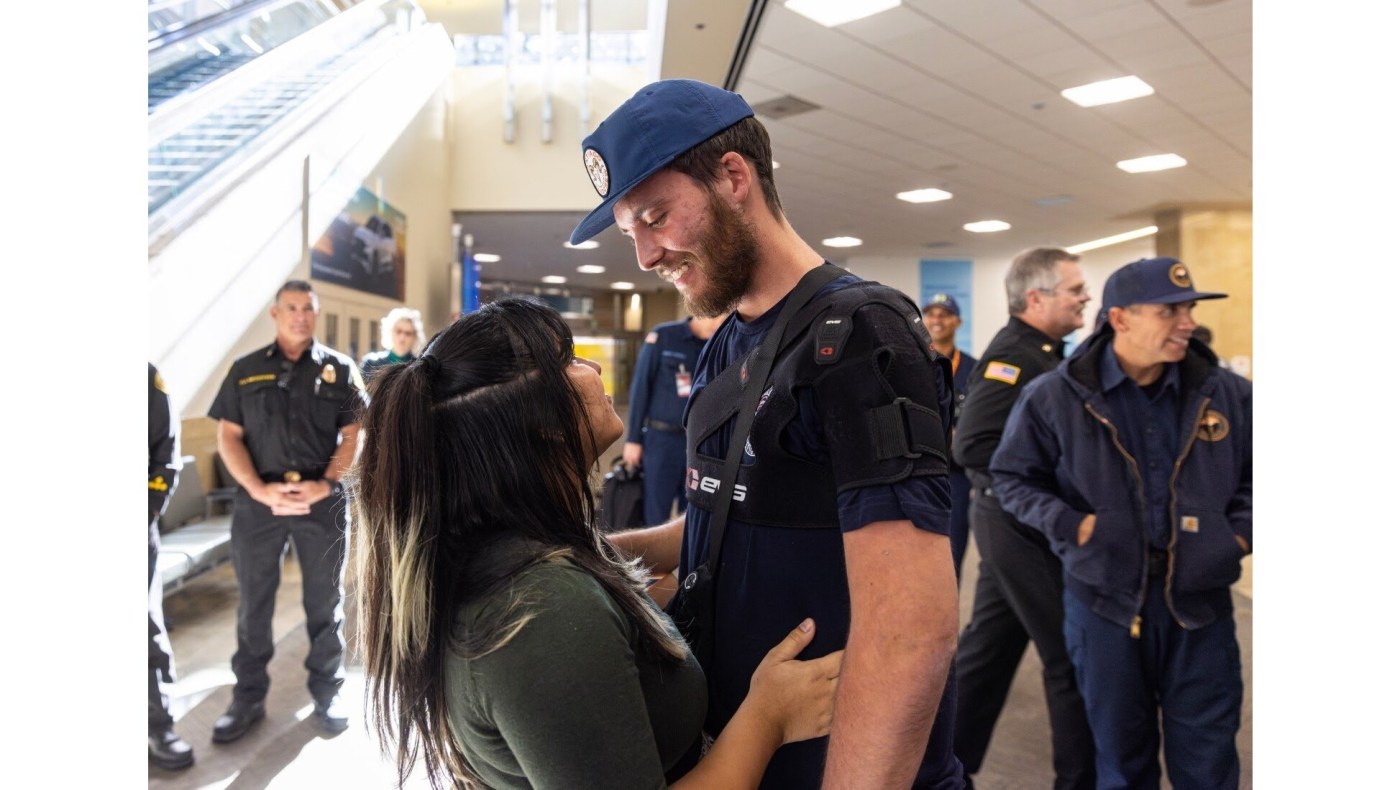A year after a rollover crash on the 241 Toll Road left several Orange County firefighters seriously injured, recovery has taken many forms. Some have returned to duty; others are navigating therapy, mobility challenges, and daily adjustments. But the support — from family members, colleagues and the fire service community — has remained constant.
Eight members the Orange County Fire Authority’s Hand Crew were heading back to camp on Sept. 19, 2024, after 12 hours battling the Airport fire, when their driver swerved to avoid a ladder in the road, causing the vehicle to roll, authorities said.
A full report on the crash has not yet been completed, according to California Highway Patrol spokesman Officer Fernando Perez.
Six of the firefighters were hospitalized in critical condition. While some have since returned to duty, others — including squad boss Matt Nichols and firefighter Andrew Brown — are still working through recovery.
Nichols sustained the most severe injuries in the crash. Though he had no broken bones, he suffered significant brain and nerve trauma that has limited the use of his arms, legs, and neck, said Jesse Hamm, president of the Orange County Professional Firefighters Association, Local 3631.
He currently is undergoing rehabilitation at a facility in the Midwest, Hamm said. His wife Carissa, a former OCFA dispatcher, has been by his side, along with their son Theo, who turned 1 in March. A video shared by Carissa showed Theo celebrating his birthday at the facility with his family.
“Carissa and Theo have been at his side 24/7, and I think that has a lot to do with his progress,” Hamm said.

Hamm visited Nichols during an earlier stage of his recovery, when Nichols was able to respond to yes-or-no questions using hand gestures.
Carissa later compiled a video of his journey using clips and photos taken throughout the year. Recent footage shows Nichols smiling again. In one scene, Theo sits on the wheelchair’s lap tray, leaning into his father’s chest as Nichols, who has regained some hand movement, places a hand on his son’s back and moves it gently. In another clip, he flexes his arm in a brief bicep curl alongside Carissa.
In August, he was even able to stand with a piece of medical equipment called an EZ stand for the first time.
While his recovery remains long and the future uncertain, Nichols already has made remarkable progress, Hamm said. The family is hopeful he’ll be transferred to a facility in Southern California by 2026—a goal they’re actively working toward, even if the timeline isn’t yet guaranteed.
Andrew Brown, one of the six critically injured firefighters, is still working toward returning to duty.
Immediately after the crash, Brown remembers being pulled from the truck and thinking only of his wife Daisy and their unborn child—hoping they would be taken care of if he didn’t make it home.
He suffered a spinal cord injury that initially left him uncertain if he would ever walk again. Doctors told him the worst-case scenario was paraplegia; the best case, walking with assistance within two years.
Within the first week of rehab, he was able to stand briefly with help. A few weeks later, he was taking assisted steps. By November, he walked off the plane into John Wayne Airport, and was greeted by his wife and a crowd of OCFA members, including his own hand crew.

The following month, he was there to witness the birth of his daughter.
Though Brown doesn’t remember much about the crash itself, he said the outpouring of support that followed was unforgettable.
“When I heard that people were donating and praying for us, I was astonished,” he said. “I’m just a regular guy.”
In addition to his spinal injury, Brown sustained two broken bones in his left arm and a labrum tear. He was treated at the same facility as Nichols.
Though OCFA covered his medical care, the crash led to income loss and unexpected expenses. Donations from colleagues and community members helped the family stay afloat.
“I couldn’t be more grateful,” Brown said.
Now, nine months into fatherhood, Brown is able to walk without issue and play with his daughter. He remains in physical therapy and hasn’t yet rejoined the hand crew, but he plans to.
“My goal is to work as hard as I can to get back to work,” he said. “It’s what I love to do.”
The crash left a deep impact on the agency, not just for the injured but for the OCFA crews who responded to the scene to help their own.
“We’re still working through the grief,” Hamm said.
State programs have helped offset some of the burden, but costs remain high, Hamm said. OCFA and Local 3631 launched a relief fundraiser through the Fallen Firefighter Relief Fund, a nonprofit founded in 1997 to help firefighter families cover essential expenses when a loved one is seriously injured or killed in the line of duty.
The community has raised more than $400,000 so far — about $100,000 short of their goal — with donations still being accepted to support Nichols’s ongoing care and recovery.
Four of the eight firefighters involved in the crash have returned to active hand-crew duty, Hamm said.
“It’s a testament to the courage and grit of these firefighters that they jumped back into it,” he said. “And I know the other four are working every day toward returning too.”





